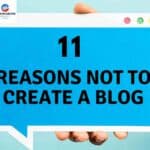The goal of these SEO Tips is to educate you on specific areas that you may not be aware of if you are not an expert in the blogging world.
We all understand the significance of implementing an SEO strategy to get high search engine placement and attract a large number of visitors to our website.
Some SEO Tips that we encounter on a regular basis
We all know that four sections primarily define SEO:
- links
- Contents
- Social media
- On-page SEO
Although the reality is that certain areas of SEO are less recognized within these vast portions, mainly if you are not an SEO specialist.
Google’s “spiders” crawl millions of websites every day, looking for problems that might damage our online placement.
These are some SEO tips that I believe will be beneficial for your project and will assist you in avoiding future penalties and, most importantly, in receiving thousands of views every month.
1. Make a Professionally Designed Website
Make a Sitemap.xml file to make it easy for search engines to index the structure of your siteThis is a file that provides information to search engines. They need to crawl and index website pages, videos, and audio more rapidly. In order to appear in Google News, a site must also have a sitemap.
Furthermore, your website should encourage users to explore and share your material. Do you sell products? At least a few optimized product photos should be shown on the site. Do you keep a blog? Include a link to your most recent blogs and articles.
These acts are popular not just with visitors but also with search engines. It is also required to include “Share” buttons for all popular social networks.
H1 / Title / Description / Keywords must be filled out appropriately on all pages of your site.
Finally, don’t overlook the importance of a visually appealing website. People will leave and never return if a site seems like an outdated web page from the 1990s. Instead, they will go for a more professional-looking competition. These are lost visitors, inbound links, social media shares, and money.
2. Make catchy headings for your posts.
The page title and heading are similar but distinct methods of referring to the same website page. The keyword-focused title is designed for search engines, whereas the standard title is intended for individuals viewing the website.
“2021 Honda Civic Review,” for example, is a Title, a brief, SEO-optimized page title that displays exclusively in search results. And “10 Reasons Why the 2021 Civic is Honda’s Best Car” is an excellent headline that will entice readers to leave a comment and share a link to the post.
As a precaution, ensure that your page titles adequately convey the page’s content. The page should not be titled “2021 Honda Civic Review” unless the content reflects this. This is a falsehood that is frowned upon by Google and other search engines. You will lose credibility, as well as maybe your ranking.
3. Frequence Publication
The most recent Google algorithm improvements provide a more significant boost to websites that post excellent material on a regular basis. Consider the following:
How often do you update your blog? How often do you make changes to your website?
Ideally, you should be able to offer meaningful information to your user community daily, but if you can’t, strive to submit at least 2-3 blog entries weekly.
Remember that the frequency with which a website is updated significantly impacts SEO.
Some SEO tips; It might be tough to find the time to create three weekly blog pieces while maintaining the same level of quality, but to help with this process, I recommend the following:
- You allow other publications to contribute material to your blog.
- We sometimes run out of ideas for articles to write. Therefore, I propose reading several articles on your topic to see how many ideas suddenly occur to you.
4. Concentrate on a single subject.
Search engines seek to provide users with the most reliable and relevant results. If you are a subject matter specialist, your website material should reflect that.
Do you want to share your recipes with the rest of the world? The site should, therefore, be devoted to food. Don’t combine pancakes and metalworking. Your website is unlikely to represent a substantial international firm or a journalistic agency that covers all themes simultaneously.
Check out our complete guide on.”The 32 Ideas to blog about.”
Specificity is essential. If you are a fisherman who specializes in fly fishing rather than deep-sea fishing, your website should reflect that. This will improve the authenticity of its material.
5. Image optimization
Web images assist in revitalizing the content. Bright, high-quality photos improve the site’s appeal. Images may draw attention to the goods or services you’re offering.
To keep readers engaged, they break up long blocks of material. Because images are vital, you should invest effort in improving them.
The first step in optimizing photos for the web is to make them smaller. Each picture must be less than one megabyte in size.
The smaller the size, the more photos are on the page. Pages will load faster if photos are resized to a maximum resolution of 1920 × 1080 pixels and saved in JPG or WEBP format. Search engines dislike sites that load slowly.
Check that the photos have the proper alt attributes. Although search engines cannot see pictures on a website, Alt properties help them classify them.
The alt text should contain a brief description of the image. Limit yourself to 125 characters.
Alt fields in content management systems (such as WordPress) enable you to input an image keyword easily. If you want to use HTML, the alt attributes function as follows:
6. Paying Google boosts SEO
The prospect of producing sponsored advertising on Google to improve SEO has always been argued. Still, if Google makes a solid promise to offer paid ads more exposure on Google’s first page, everything implies that it is more of a reality than the standard statement heard at every SEO conference.
The issue is that the loss of Facebook visits causes many businesses to produce sponsored advertisements in order to regain lost traffic.
What is evident is that the two main ones (Google and Facebook) make a clear commitment so that we “dig out our pockets and go to the checkout.”
7. Internal Linking
When other sites connect to a site, it gets authority in search engines, particularly if those other pages are trusted and popular. These are known as backlinks. However, you have little influence over them. Promote, enhance, and hope that your efforts are recognized.
However, you have complete control over internal connections. To entice readers further, connecting articles on the same subject is vital.

In most cases, the text (link anchor) must be converted into a link. Visitors use these terms to go from one page to the next. For example, if you have an article on spark plugs and want to link to it from an article about engine care, use the hypothetical anchor text “replace spark plugs” to gain more SEO.
Read more on “How To Monetize Your Blog With Affiliate Marketing.”
Internal linkages should be subtle and natural. A paragraph containing just links is difficult to understand. Therefore, search engines will reject it. You must also ensure that the connections function properly. Broken links suggest that you are not adequately managing your website, and hence search engines may punish it. Dead Link Checker will assist you in checking a website for broken links.
8. Your web addresses (URLs)
SEO must also be applied to URLs. Search engines treat keywords in a site’s URL similarly to keywords on a page.
Do you utilize dynamic URLs based on numbered pages on your website? If this is the case, replace them with static URLs.
Consider this imaginary blog post: HTTPS:// Financebode.com/post/detail?id=27869. The number at the end of the URL denotes a particular post, but it says nothing about it.
To remedy this, go to your site’s backend and activate static URLs so you may include crucial keywords in the URL.
The identical innovative vehicle post will display as HTTPS:// Financebode.com/post/smart-cars with static URLs. Search engines prefer this more descriptive URL syntax. Remember that brevity is essential, so don’t make the URL keyword-filled text. Finally, instead of placing all the words in a URL, use hyphens to separate them.
9. Get to know your audience and forget about keywords.
There is no need to stress about repeating the term, which is known in SEO as density. Previously, the density was a constant number that fluctuated between 2 and 3%, but recent updates in the algorithm seek better naturalness in the material. Thus the density must be lowered and always less than 2%. The most frequent density is presently between 1% and 2%.
Do you still use this metric? What is the density of your content?
Currently, keyword analysis is wholly inadequate unless supplemented with a study of the most popular material and subjects among our followers and admirers.
Other keyword research tools are available, but the most popular is Google Keyword Planner, previously known as the Webmaster Keyword Tool.
We may use the following techniques to learn about the most popular subjects on social media:
- Buzz sumo. It displays the most popular social media links based on a given subject. We may also utilize it to identify the theme’s influences.
- Crawlystic in social situations. A tool for analyzing how and how often a link is shared on social media.
- Control me. It analyzes our Twitter profile and displays the most relevant material, the most often used hashtags, and the followers that have made us the most mentions.
- PeerIndex. This tool will assist us in identifying the greatest brand influencers for each theme.
- Swayy. Analyze the subjects that your target audience is most interested in.
- Everest. Filter and choose the most recent and relevant material on your favorite subjects.
Some SEO tips:
- Learn all you can about each of your audience.
- Make an effort to engage with brand influencers who can assist you in making the material go viral.
- Remember the relevance of Google+ in SEO, regardless of whether you like this social network.
10. webpage loading speed
According to Google data, if a site takes more than three seconds to load, 53% of mobile viewers abandon it. Visitors’ time is precious, so don’t offer them a cause to leave if your site is sluggish.
Google PageSpeed Insights, Google’s Test My Site, or Pingdom may help you determine your site’s speed. These tools provide specific information on how to enhance the load time of your website. This includes updating or improving image and script delivery, which might take a long time to load.
If you use WordPress, you should uninstall any unwanted plugins. Try the WP-Rocket plugin, which caches pages for speedier loading.
11. SEO’s best friend is content, but not just any material.
According to Dr. joe, “content that helps is always preferable to material that sells.” If we want our content to attain vital search engine placement or SEO, the following factors are required:
- Before you post, please get to know your followers’ and readers’ interests and preferences; it’s not about creating material with a business or sales goal in mind, but rather something your audience wants from you.
- According to Laura Fitton, “the helpful is the new viral,” therefore, keep in mind that the more beneficial the material you make for your audience, the more significant the viral impact you will obtain.
- Invest in material that is longer than 1,000 words. It is all about creating high-quality content and delving into a particular subject.
- Make it visually appealing to draw the user’s attention. According to Neal Schaffer, “90% of all information transmitted to the brain is visual, and this information is processed 60,000 times faster than text,” so we don’t make “endless jabbering that bores even a buffalo.” Still, instead, we give the text the most appealing and visually possible format, as well as the addition of complements such as good graphics and audiovisual material.
SEO guidelines for selecting good content:
- Content marketing reigns supreme as long as you know how to choose suitable themes.
- Instead of creating just 300 words long material, attempt to exceed 1000 words.
- Hitting the theme will boost the theme’s virality.
- Because the weekend receives the most social bookmarking, a decent publishing frequency might be Monday, Wednesday, and Friday.
12. Creating a reference blog.
A blog is an excellent tool for any business, mainly for developing a brand blog that is a reference in a given field and the thousands of monthly views I can receive if I do things correctly.
Although, in the present context, there is a lot of rivalry and a vast number of influential blogs, positioning it at the SEO level will be challenging and time-consuming.
SEO methods for attracting thousands of visitors every month
- Stake. A blog is a wholly bidirectional and very live tool in which we must encourage user participation; however, this requires that the people who manage the blog be very participatory and respond to the readers immediately; reply to comments, respond to emails, share through social networks, and so on.
- Create a personal relationship. As more consumers prefer a “person to person” relationship over a relationship with the company, it is critical to focus not only on the firm’s brand but also on the brand of every publisher that publishes content on the blog.
- Domain or subdomain? A common mistake is installing the blog in a subdomain, assuming it will help with SEO. However, this is not the best option. The explanation is simple: when we utilize a subdomain, the relevance of a site spreads from the root to reach each of the sections or sections, as well as all of its web pages, providing a tremendous boost to our SEO.
- Mention influential people in your writings. When we highlight significant persons in our articles, we gain more confidence in our approach, resulting in increased security and trust. Another essential component is that it allows us to rapidly connect with strong topic influencers who can help us increase the reach of this content.
- Create a mailing list. With hundreds of blog subscribers, we can increase website visits by 5 to 10% using an email marketing technique. The goal is to send one email weekly to inform our readers about new blog content. There are several ways to attract subscribers, but the most well-known are a free ebook, a free course, or a social media contest.
SEO tips for starting a successful blog:
- Involvement and participation.
- Relationships between people, not between businesses.
- Avoid hosting your blog on a subdomain.
- Mention influential people in your writings.
- To improve visitor traffic, create a subscription list.
13. Website errors
There are several faults that we make while developing a website, but I will only focus on those that affect SEO and will adhere to the three priority levels that MOZ employs:
Priority number one:
- There is duplicate material. This is any website’s Achilles’ heel since our same material reaches 25% of the total. We will be exposed and willing to incur a significant penalty from Google.
- Errors occurred when indexing a page.
- Pages that lack a Meta Title.
- 5XX server failures.
- There were 4XX client errors.
All of these characteristics are critical to SEO and have a negative impact if several mistakes of this sort accrue.
Priority number two:
- Pages that lack a meta description. It is critical to provide the Meta Description for every page we want to index. It must also be distinct and distinct for each page.
- Meta title duplicate. My website has two or more pages with identical Meta titles. This is one of the most common mistakes when the programmer who creates the website has no understanding of SEO and, for example, comes up with the beautiful idea of putting the business name as the Meta Title and applying it to all of its pages.
- The meta title is too lengthy. The Meta Title must be more than 70 characters long.
- Robots.txt has banned the browser.
- The meta title is too short. The Meta Title should not be fewer than 40 characters and should be between 50 and 70 characters.
- Redirections are only temporary. Nothing occurs when we utilize a temporary redirection, but accumulating a high number of them may be detrimental to our SEO.
Priority number three
- There are too many dynamic URLs. Use a URL that is brief and easy to remember.
- The URL is too lengthy. It is advised that the URL include no more than 115 characters. How long was the most extended URL you’ve ever seen?
Some SEO tips. It is challenging to create a website free of the faults stated above, but we should try the following:
- Repair high-priority bugs.
- Fix medium-level bugs.
- Fix as many minor issues as feasible.
14. Share the content on social media multiple times.
According to a KISSmetrics study, publishing information on many social media platforms can double the number of visitors we receive from this medium.
Most of us do this on a regular basis, but we don’t always know how many times we can repeat the same content.
SEO tips:
- To improve traffic to your site, share the material on social media multiple times.
- Create a publication schedule for each social profile, keeping in mind that you don’t want to bore and fatigue your fans.
15. Meta description writing with information packaging
A meta description, also known as a snippet, is a short paragraph that appears in the HTML code of each page. Meta descriptions display in search results beneath page titles and provide extra information about the page’s purpose. Longer descriptions (approximately 150 characters!) that won’t fit in the page titles can be written here. Don’t put all of your keywords there. This is referred to as keyword stuffing and is frowned upon by search engines. Instead, create your meta description in simple English.
Put a meta description in each page’s “Title” area if you’re comfortable manipulating the HTML. Here’s an illustration.
Consider the meta tags for the description and keywords. These are the primary places where you should concentrate your SEO efforts.
You can modify meta descriptions in many content management systems without having to go into the HTML. There are a lot of WordPress plugins, such as All in One SEO Pack and Yoast SEO, that allow you to write meta descriptions without having to work with code.
Conclusions for SEO Tips
There are other implications we can draw from all of these SEO tips, but the following are the most important:
- Set aside sometime each week to investigate and eradicate potential website faults.
- Publish content on your blog on a regular basis, at least 2 to 3 times per week.
- The payment mechanism is becoming increasingly important in online marketing.
- Backlinks will begin to lose importance in the coming years. So focus majorly on internal linking.
- Forget about keywords and get to know your followers.
- Choose beneficial material over sales every time.
- You can boost the number of visitors by creating a reference blog.
- Publishing information on social media many times might quadruple the number of visits from social networks.
If you enjoyed the post “15 Simple SEO Tips To Boost Your Website Traffic,” please share it with a friend.
I hope you find these SEO tips beneficial, and please feel free to tell us any other recommendations you have.





